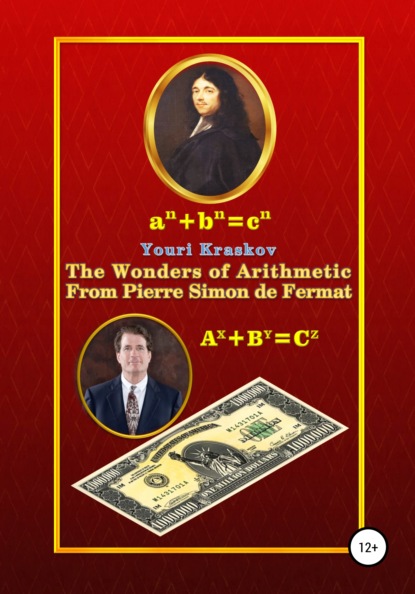По всем вопросам обращайтесь на: info@litportal.ru
(©) 2003-2024.
✖
The Wonders of Arithmetic from Pierre Simon de Fermat
Год написания книги
2021
Настройки чтения
Размер шрифта
Высота строк
Поля
+?
where ?
=N?m
(1)
It is quite obvious that ?
must be an S-number since otherwise this would contradict our assumption about the number N. Then we proceed the same way as in our example with the number 41 i.e. represent the supposed number as
N = m
+?
where ?
=N?m
Now ?
should also be an S-number. And here so we will go down to the very end i.e. before
?
=N?m
=N?k and ?
=N?m
=N–1 (2)
Thus, in a sequence of numbers from ?
to ?
, all of them must be S-numbers i.e. each of them will consist of a sum minimum of k k-angle numbers, while our supposed number N will consist minimum of k+1 k-angle numbers. From (1) and (2) it follows:
N? m
=S
(3)
Thus, if we subtract any smaller polygonal number m
from our supposed number N then according to our assumption, the result should be only an S-number. Of course, this condition looks simply unbelievable and it seems that we are already at target, but then how can one prove that this is impossible? …
If we gave an answer to this question here, then this famous Fermat's theorem would immediately turn into the most common school problem and interest to it would be lost. To prevent this from happening, we will stay on the fact that the proof is presented here only by 99% and the remaining 1% will be offered to those who will be interested in order to appreciate the true magnificence of this scientific achievement of Fermat, especially in comparison with the Cauchy’s GFT proof.[42 - Facsimile of the edition with the Cauchy's GTF proof was published by Google under the title MEMIRES DE LA CLASSE DES SCIENCES MATHTЕMATIQUES ET PHYSIQUES DE L’INSTITUT DE France. ANNEES 1813, 1814, 1815: https://books.google.de/books?id=k2pFAAAAcAAJ&pg=PA177#v=onepage&q&f=false (https://books.google.de/books?id=k2pFAAAAcAAJ&pg=PA177) What we need is on page 177 under the title DEMONSTRATION DU THЕORЕME GЕNЕRAL DE FERMAT, SUR LES NOMBRES POLYGONES. Par M. A. L. CAUCHY. Lu ? l’Acadеmie, le 13 novembre 1815 (see Pics 34, 35). The general proof of Cauchy takes 43 (!!!) pages and this circumstance alone indicates that it does not fit into any textbook. Such creations are not something that students, but also academics are not be available because the first cannot understand anything about them and the second simply do not have the necessary time for this. Then it turns out that such proofs are hardly possible to check how convincing they are i.e. are they any proofs in general? But if Cauchy applied the descent method recommended by Fermat, then the proof would become so convincing that no checks would be required. A very simple conclusion follows from this: The Fermat's Golden Theorem as well as some of his other theorems, still remain unproven.]
Pic. 34. Title Page the Cauchy's Proof
of the Fermat's Golden Theorem
Pic. 35. One of 43 Pages the Cauchy's Proof
of the Fermat's Golden Theorem
3.4.3. Archimedes-Fermat Problem
The problem statement is as follows:
Let any non-square number be given, you need to find an infinite number of squares, which after multiplication by this number and increasing by unit, will make a square.
Fermat proposed finding solutions for the numbers 61, 109, 149, and 433 [36].
The English mathematician John Wallis managed to find a way to calculate the required numbers using the Euclidean method of decomposing an irrational number into an infinite common fraction. He published his decision under the name "Commercium epistolicum" see pic. 37-38.
Pic. 36. John Wallis
Pic. 37. Title Page of Wallis's Publication Commercium Epistolicum
Although Wallis did not give a complete proof the validity of this method, Fermat nevertheless admitted that he had coped with the task. Euler came very close to the solution when he showed that this fraction is cyclical, but he was not able to complete the proof and this task was finally solved by Lagrange. Later, this Fermat's task also was solved by Gauss in his own way, but for this purpose the extensive theory he created called “Arithmetic of deductions” was involved. And everything would be fine if the Lagrange's proof was not in the category of highest difficulty and the Gauss decision was not based on the most complicated theory. Fermat himself clearly could not follow such ways. About how he himself solved this problem, he reports in the letter-testament to Carcavy in August 1659 [36]: “I recognize that Mr. Frenicle gave various special solutions to this question as well as Mr. Wallis, but a common solution will be found using the method of descent applied skillfully and appropriately." However, this Fermat's solutions so remained as the secret behind seven seals!
Pic. 38. Page 64 Commercium Epistolicum
Demonstrating Wallis Method
We will try here slightly to open the veil over this mystery. To do this, we will look at a simple example of Wallis calculations and then compare it with how one could do these calculations using Fermat's method. So, we need to find the smallest numbers x and y that satisfy the equation Ax
+ 1 = y
. Let A = 29 then calculations by the Wallis method look as follows [32]:
From this sequence of calculations, a chain of suitable fractions is obtained by backward i.e. from a5 to a0 and looks like: 5/1; 11/2; 16/3; 27/5. As a result, we get 70/13. Then the minimum solution would be:
x
?29+у
=(13?29+70)
=1820?29+9801; x
=1820; y
=9820





